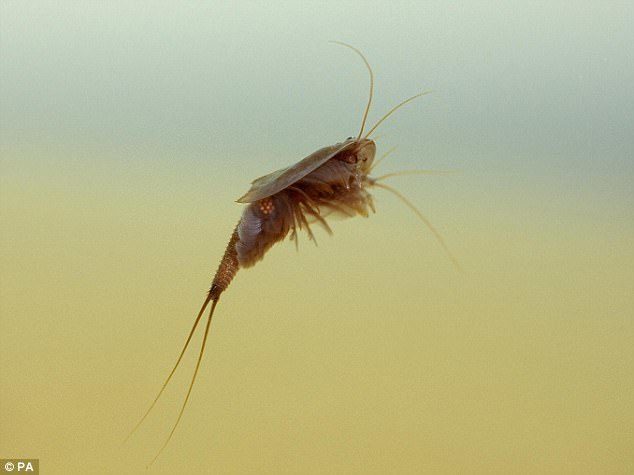
Crustaceans, such as the tadpole shrimp (pictured), are eating plastic, scientists have confirmed
Sea creatures in one of the deepest places on Earth have been found for the first time with plastic fibres in their stomachs.
Crustaceans almost seven miles down in the darkest depths of the Pacific Ocean are eating plastic, scientists have confirmed.
The finding, which is the deepest possible record of microplastics, means nothing living in the world's seas is now likely to be untouched by manmade rubbish.Every creature sampled at the bottom of the Mariana Trench in the Pacific had swallowed microscopic fragments including nylon, polyethylene and polyvinyls similar to PVC.Dr Alan Jamieson, from Newcastle University, who led the study, called the results 'immediate and startling'.
He said: 'The deep sea is not only the ultimate sink for any material that descends from the surface, but it is also inhabited by organisms well adapted to a low-food environment and these will often eat just about anything.
'This study has shown that manmade microfibres are culminating and accumulating in an ecosystem inhabited by species we poorly understand.'
Researchers first found poisonous chemicals, banned in the 1970s and thought to have spread through plastic debris, in the deepest part of our oceans in February.
That was when it was realised manmade waste had got into crustaceans' bodies through their fatty tissue.
The new findings, accepted for publication but not yet published, show for sure that the tiny creatures are eating the plastic fibres.
Samples of 90 individual crustaceans were taken from the ultra-deep trenches which span the entire Pacific Ocean - including the Mariana, Japan, New Hebrides and Kermadec trenches.
The deepest point, Challenger Deep in the Mariana Trench, is a staggering 6.7 miles down.The fragments identified include rayon, the world's first manmade fibre developed in the 19th century as a substitute for silk, as well as nylon and unidentified polyvinyls closely resembling polyvinyl alcohol or polyvinylchloride - PVA and PVC.
Dr Jamieson said: 'This type of work requires a great deal of contamination control but there were instances where the fibres could actually be seen in the stomach contents as they were being removed.
'We felt we had to do this study given the unique access we have to some of the most remote places on earth, and we are using these samples to make a poignant statement about mankind's legacy.'
The proportion of sea creatures which had ingested plastic ranged from 50 per cent in the New Hebrides Trench to every creature at the bottom of the Mariana Trench.
The team used deep-sea 'landers', which free-fall to the ocean floor to carry out a monitoring and sampling tasks.
An estimated 300 million tonnes of plastic now litters the oceans, with more than five trillion plastic pieces weighing over 250,000 tons currently floating on the surface.DR Jamieson said: 'These observations are the deepest possible record of microplastic occurrence and ingestion, indicating it is highly likely there are no marine ecosystems left that are not impacted by anthropogenic debris.'

Reader Comments
Obviously humanity is a crazed experiment gone awry.
I only keep trying to live right, in order to gain a better incarnation, on a distant cleaner world. In another galaxy.